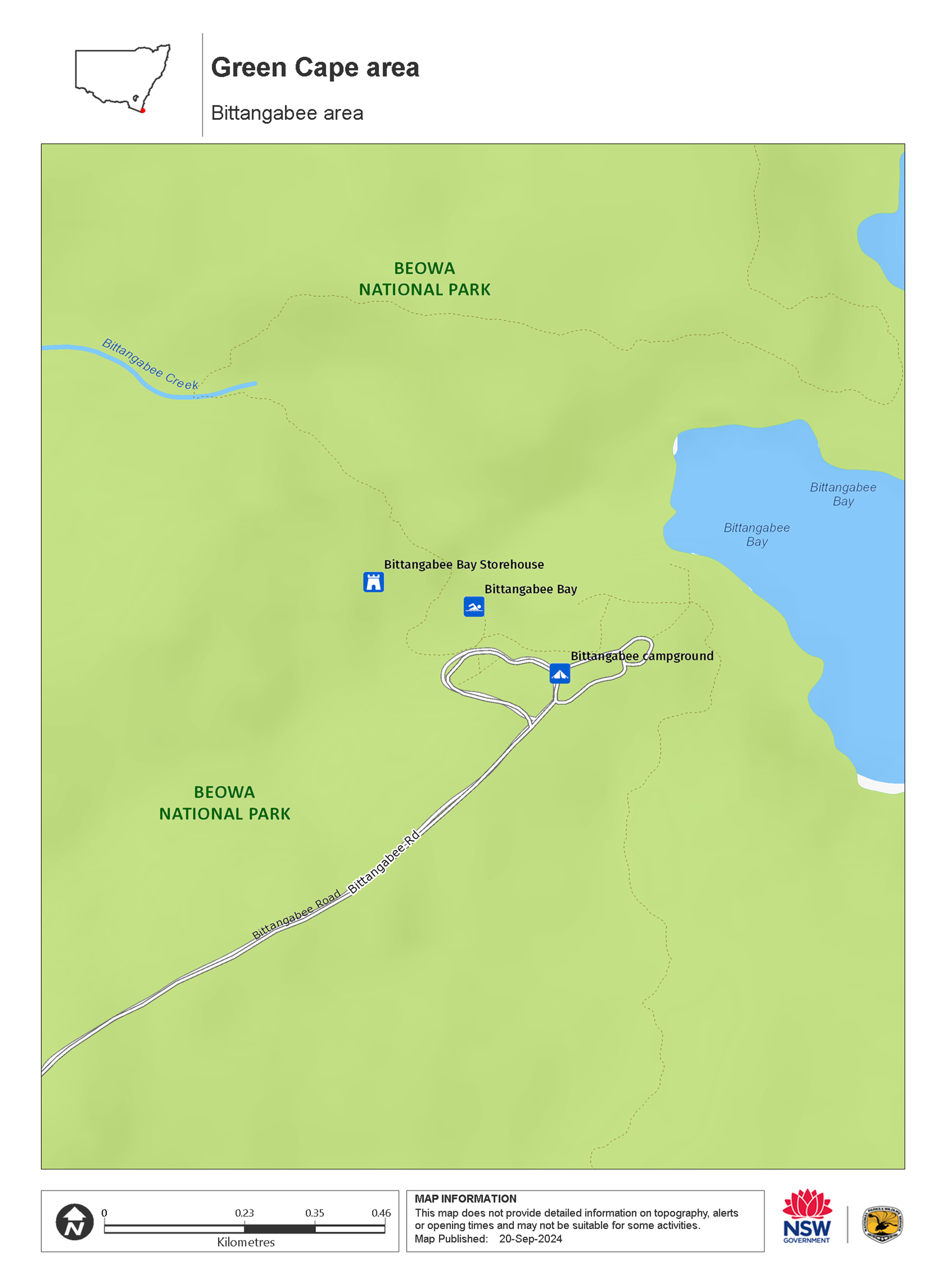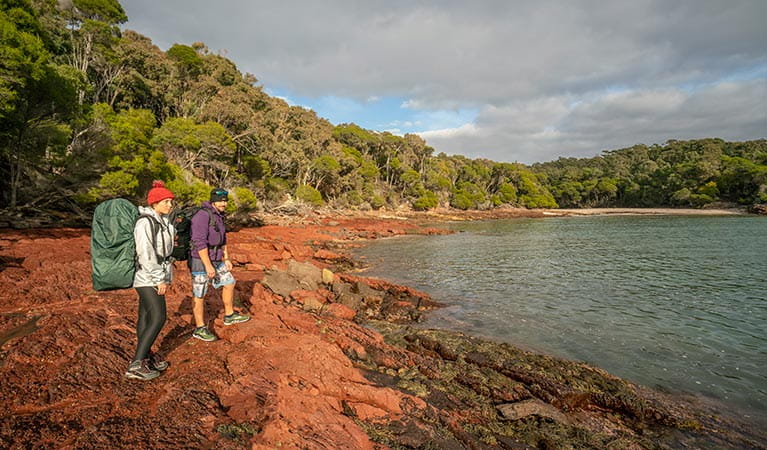Overview
Green Cape area is the southern section of Beowa National Park, located south of Eden. It’s your gateway to the Light to Light walk, camping, lighthouse accommodation and superb whale watching.
Read more about Green Cape area
The Green Cape area stretches from Boyds Tower, at the southern headland of Twofold Bay, to Disaster Bay at the southernmost tip of the park. And so does the 32km Light to Light walk which traces the park’s spectacular rocky coastline. It’s one of the best coastal walks in NSW.
Camp close to secluded beaches and bays at Saltwater Creek and Bittangabee campgrounds. You won’t be camping alone—the bush is alive with wildlife so you might be sharing with wombats, kangaroos, wallabies and superb lyrebirds. If you’re after a little bit of luxury, stay in a heritage lighthouse cottage at Green Cape and wake up to the waves.
The coast around Eden is one of Australia’s best whale watching destinations. To watch the action from land, you’ll get a good view from Boyds Lookout and Disaster Bay lookout. Drop in to Davidson Whaling Station Historic Site if you’re interested in the area's shore-based whaling history.
If you’re short on time, day trippers can still find plenty to do. Walk a small section of the Light to Light walk or stop at Boyds Tower for views of the ocean and the heavily folded red rock beds at Red Point.
Local alerts
For the latest updates on fires, closures and other alerts in this area, see https://www.nationalparks.nsw.gov.au/visit-a-park/parks/green-cape-area/local-alerts
Map

Map

Map

Map legend

Contact
- in Beowa National Park in the South Coast region
The Green Cape area of Beowa National Park is always open but may have to close at times due to poor weather or fire danger.
-
$8 per vehicle per day in the Green Cape area of the park (south of Eden).
Buy annual pass. -
-
Merimbula office
02 6495 5000
Contact hours: Monday to Friday and some weekends during peak holiday periods, 10am to 3pm. - 47 Merimbula Drive, cnr Sapphire Coast Drive, Merimbula NSW 2548
-
Email: npws.sapphirecoast@environment.nsw.gov.au
-
Merimbula office
Visitor info
All the practical information you need to know about the Green Cape area.
Getting there and parking
Get driving directions
To get to attractions in the Green Cape area of Beowa National Park from Merimbula (40mins):
- Travel on the Princes Highway past the town of Eden for around 16km.
- Turn left onto Edrom Road.
- Travel 4km along Edrom Road and then turn right onto Green Cape Road.
- Travel along Green Cape Road through Forestry for approximately 8km until you hit the park entrance.
- Or to get to the start of the Light to Light walk at Boyds Tower, travel along Edrom Road for 10km and turn right on Boyds Tower Road.
You can also fly into Merimbula Airport from Sydney and Melbourne.
Parking Show more
- Bittangabee Bay See on map
- Bittangabee Bay Storehouse See on map
- Bittangabee campground See on map
- Accessible parking at Boyds Tower See on map
- Accessible parking at Boyds Tower walking track See on map
- Disaster Bay lookout See on map
- Green Cape Lightstation Keepers' Cottages See on map
- Accessible parking at Green Cape lookout See on map
- Mowarry campground See on map
- Saltwater Creek campground See on map
- Telegraph Station bunkhouse See on map
Road quality
2WD vehicles can access all areas in the Green Cape area but Green Cape Road can be very rough and bumpy. Please watch out for logging trucks that share this road.
Best times to visit
Autumn
Cook up freshly caught fish by the campfire at Saltwater Creek campground. Pulpit Rock and City Rock are popular land-based fishing spots for experienced fishers (you need a fishing licence).
Spring
Are you wild about whales? Plan your visit around the Eden Whale Festival in early November and combine it with a whale watching tour.
Summer
Wake up at sunrise for a morning swim at Bittangabee Bay or Saltwater Creek and spend your days paddling, swimming and surfing. Bring your surfboard if you’re camping at Saltwater Creek campground—it’s close to the beach.
Winter
Hike the multi-day Light to Light walk when it’s nice and cool and the banksias are in bloom. If you’re starting your hike from Green Cape Lightstation, rest your head and take a hot shower at Telegraph Station bunkhouse before continuing. You can also walk the Light to Light in shorter sections if you’re short on time.
Facilities
Toilets Show more
- Bittangabee Bay
- Bittangabee campground
- Boyds Tower
- Boyds Tower walking track
- Green Cape Lightstation Keepers' Cottages
- Green Cape lookout
- Mowarry campground
- Saltwater Creek campground
- Telegraph Station bunkhouse
Showers
Picnic tables
Barbecue facilities
Drinking water
Maps and downloads
Fees and passes
$8 per vehicle per day in the Green Cape area of the park (south of Eden).
- All Parks Pass - For all parks in NSW (including Kosciuszko NP) $190 (1 year) / $335 (2 years)
- Multi Parks Pass - For all parks in NSW (except Kosciuszko) $65 (1 year) / $115 (2 years)
- Single Country Park Pass - For entry to a single park in country NSW (except Kosciuszko). $22 (1 year) / $40 (2 years)
- Country Parks Pass - For all parks in Country NSW (except Kosciuszko) $45 (1 year) / $75 (2 years)
Annual passes and entry fees (https://www.nationalparks.nsw.gov.au/passes-and-fees)
Permitted
Camp fires and solid fuel burners
Camping
Cycling
You can only cycle or mountain bike on vehicle tracks. No cycling on walking tracks.
Fishing
A current NSW recreational fishing licence is required when fishing in all waters.
Prohibited
Gathering firewood
Generators
Pets
Pets and domestic animals (other than certified assistance animals) are not permitted. Find out which regional parks allow dog walking and see the pets in parks policy for more information.
Smoking
NSW national parks are no smoking areas.
Nearby towns
Eden (33 km)
Eden is a historic whaling town, ideal for a whale-watch tour. It's built around a promontory that juts into Twofold Bay.
Merimbula (60 km)
The main coastal towns of the Sapphire Coast include Bermagui, Tathra, Merimbula and Eden. This stunning coastline has sparkling beaches and bays, lakes and national parks, all accessible via excellent walking tracks and coastal drives. You'll find beaches just perfect for surfing, swimming and walks.
Learn more
Green Cape area is a special place. Here are just some of the reasons why:
Plants and animals protected in this park
Animals
-

Yellow-tailed black cockatoo (Calyptorhynchus funereus)
The yellow-tailed black cockatoo is one of the largest species of parrot. With dusty-black plumage, they have a yellow tail and cheek patch. They’re easily spotted while bird watching, as they feed on seeds in native forests and pine plantations.
-

White-bellied sea eagle (Haliaeetus leucogaster)
White-bellied sea eagles can be easily identified by their white tail and dark grey wings. These raptors are often spotted cruising the coastal breezes throughout Australia, and make for some scenic bird watching. Powerful Australian birds of prey, they are known to mate for life, and return each year to the same nest to breed.
-

Superb lyrebird (Menura novaehollandiae)
With a complex mimicking call and an elaborate courtship dance to match, the superb lyrebird is one of the most spectacular Australian animals. A bird watching must-see, the superb lyrebird can be found in rainforests and wet woodlands across eastern NSW and Victoria.
-

Eastern ground parrot (Pezoporus wallicus wallicus)
The eastern ground parrot is a beautiful, ground-dwelling native bird that lives in low heathland habitat along the NSW North and South coasts and escarpments. It’s listed as a vulnerable species in NSW.
-

Lace monitor (Varanus varius)
One of Australia’s largest lizards, the carnivorous tree-dwelling lace monitor, or tree goanna, can grow to 2m in length and is found in forests and coastal tablelands across eastern Australia. These Australian animals are typically dark blue in colour with whitish spots or blotches.
Plants
-

Black sheoak (Allocasuarina littoralis)
The black sheoak is one of a number of casuarina species found across the east coast of Australia and nearby tablelands. Growing to a height of 5-15m, these hardy Australian native plants can survive in poor or sandy soils. The barrel-shaped cone of the black sheoak grows to 10-30mm long.
-

Grey mangrove (Avicennia marina)
Grey mangrove is the most common and widespread mangrove found within intertidal zones across Australia, and throughout the world. Growing to a height of 3-10m, they thrive best in estuaries with a mix of fresh and salt water. They excrete excess salt through their long thick leaves, and absorb oxygen through their aerial root system.
-

Old man banksia (Banksia serrata)
Hardy Australian native plants, old man banksias can be found along the coast, and in the dry sclerophyll forests and sandstone mountain ranges of NSW. With roughened bark and gnarled limbs, they produce a distinctive cylindrical yellow-green banksia flower which blossoms from summer to early autumn.
Environments in this area
- Desert and arid shrubland environments
- Eucalypt forest environments
- Grassland environments
- Heathland environments
- Woodland environments
- Coastal environments
What we're doing
Green Cape area has management strategies in place to protect and conserve the values of this park. View the detailed park and fire management documents. Here is just some of the work we’re doing to conserve these values:

